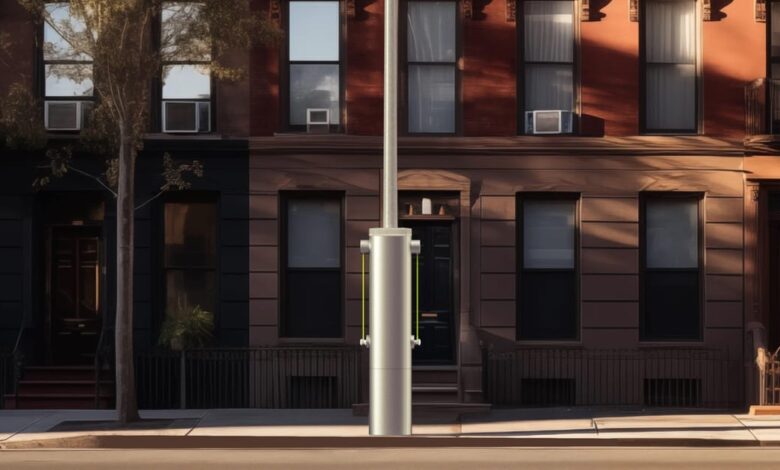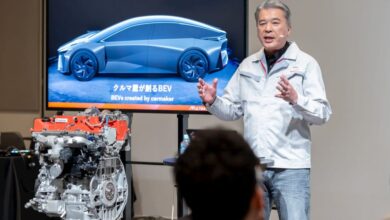Can streetlights unlock big city EV charging? This…

The Voltpost is also designed to minimize the threat of accidents involving charging cords and passersby. For one, the port for its retractable cable is mounted about 8 feet off the ground, minimizing the risk that low-slung cables will become tripping or snagging hazards for passing cars, trucks, buses, bicyclists, pedestrians, or wheelchair users.
Voltpost also designed the shape of its charging handle with safety in mind. Standard charging handles look like gun-shaped gasoline station dispensers and “stick out almost a foot into traffic,” Mairo said, making them vulnerable to being clipped by passing vehicles. Voltpost’s patent-pending plug handle looks more like a big glowing doorknob with a cord that extends from it at a 90-degree angle to lie flat against the car it’s plugged into, reducing the risk of accidental snagging.
Even the most thoughtful and tamper-proof designs can’t guard against 100 percent of the damage that may occur, Mairo noted — that’s why Voltpost says it has also made its tech easy to repair.
The Voltpost system consists of four aluminum-shielded quadrants that clip onto a collar mounted to the light post, which allows installation in less than an hour for a wide variety of pole shapes and sizes, Mairo said. It also allows damaged or malfunctioning quadrants to be removed and replaced with new ones, which is a lot faster and easier than “having someone come out and do on-site repairs,” he said.

As for letting EV drivers know where to find its chargers, Voltpost has a mobile app and web interface to manage location, reservation, and payment services — an increasingly standard feature for EV charging networks. The startup has also designed a back-end software system to track charger performance and status and provide other support for the city governments or electric utilities that make up Voltpost’s customer base.
Some cities own and operate their own streetlights, while others lease them from electric utilities that are responsible for maintaining and operating them. For either class of customer, Voltpost plans to bundle its hardware, installation, software, and maintenance costs into a simple subscription fee and to let the city or utility decide how it wants to charge EV drivers, set up reservation systems, manage payment methods, and otherwise run them to meet their particular goals.
To date, Voltpost has raised $5 million of private funding, including a $3.6 million seed financing last year led by RWE Energy Transition Investments, the venture arm of German utility and energy company RWE. Other investors include Good News Ventures, Climate Capital, Twynam Funds Management, and the Exelon Foundation, the nonprofit arm of U.S. utility company Exelon.
Mixing and matching the urban EV-charging options
Curbside charging isn’t the only form of EV charging that cities will need, of course. At Voltpost’s San Francisco event last week, Mairo shared the stage with Jake Potent, director of public policy and government relations for Revel, a New York City–based startup that’s become the biggest provider of high-speed EV charging in New York City behind Tesla, largely to serve its all-EV rideshare fleet.
Rideshare drivers who need to charge quickly, and often, are ideal anchor customers to support the high cost of building EV charging in dense urban environments, Potent said. But “we’re never going to build out enough fast charging for everyone” driving an EV in New York City or in San Francisco, where the startup is planning its next expansion.
Henna Trewn, a program manager for the San Francisco Environment Department, agreed that cities need a combination of fast-charging and slow-charging options to help residents make the switch to EVs. Other U.S. cities deploying curbside charging include Boston, Chicago, and Seattle.
San Francisco is exploring options for curbside charging but faces competing pressures when it comes to picking the right combination of charging options, Trewn said. “We’re a very congested city and have very limited parking. There’s a high demand for curb space,” she said. “How do we prove that doing something there is future-proofing for the demand to come?”
Voltpost’s modular design may give cities more options to adapt to changes in the fast-evolving EV charging landscape, Mairo said, such as the ongoing shift among EV- charger manufacturers and automakers from the combined-charging-system standard to the North America Charging Standard developed by Tesla.
The same modularity can allow Voltpost’s product to do things besides charging cars. That could include serving as cellular repeater stations — the company is in discussions with 5G carriers, Mairo said, though he declined to provide more details — or as sensor platforms for various “smart city” services, a much hyped opportunity for earning money from data collected from digital infrastructure, including LED streetlights themselves.
But right now the firm is focused on getting its newly unveiled EV charging tech into as many light posts as it can — starting first with Chicago, Detroit, and New York, where it hopes to start deploying on some city streets later this year.



